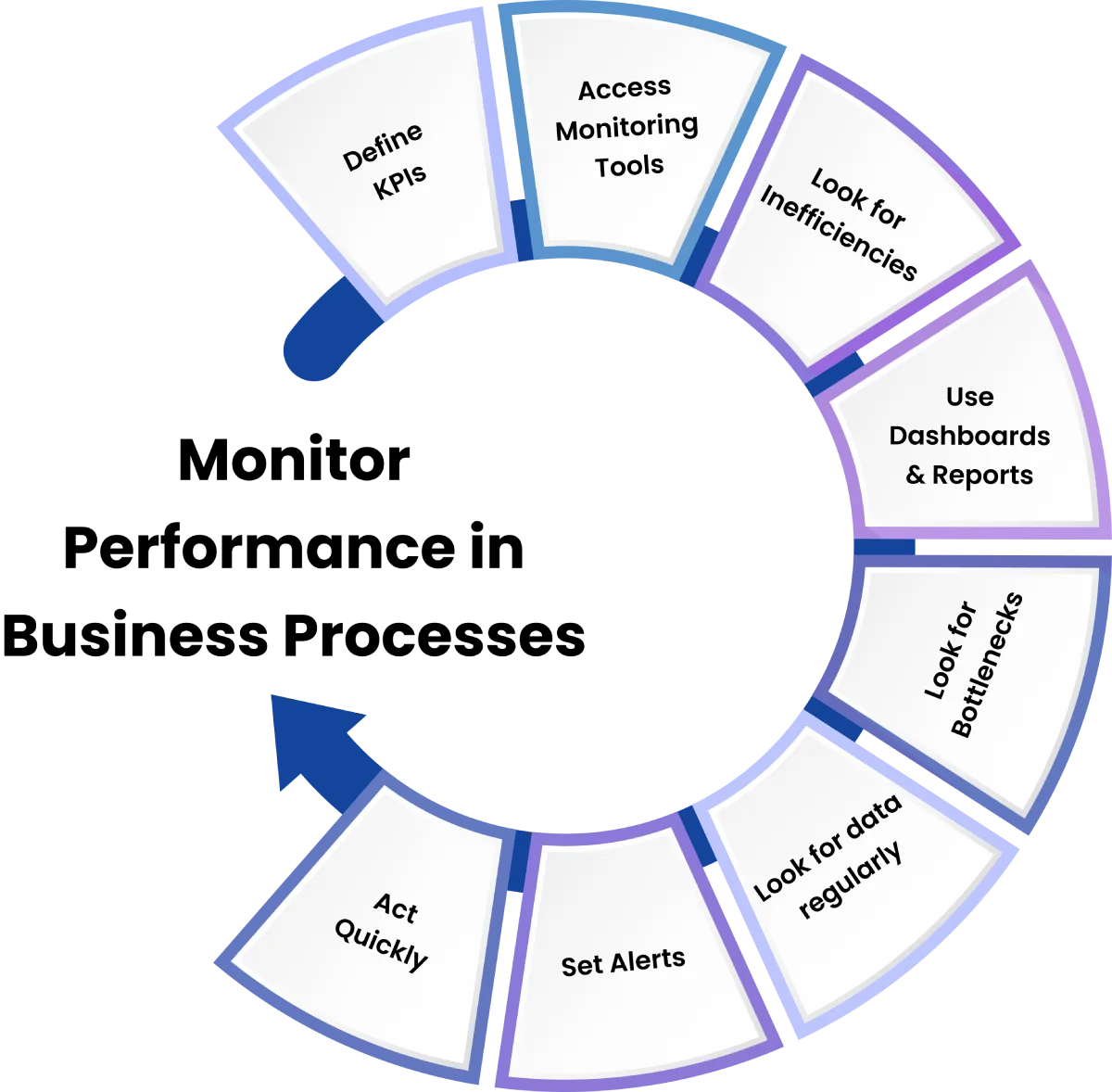Home / B / Business Process Monitoring (BPM)
Business Process Monitoring (BPM): Meaning, Benefits, Components and Performance Monitoring
Modern enterprises have many different business processes in different departments: sales, HR, finance, marketing, operations, etc. In many organizations, these processes grow and develop from their original, simple forms to complex systems from which it is difficult to maintain smooth and efficient corporate outcomes. Business Process Monitoring (BPM) refers to the observation of the operational performance of your business processes. It assists you in discovering errors early, improving practices, and making conscious decisions.
Having a regular, professional duty to observe your processes will ensure you can identify where things went wrong and rectify them. Even though we can specify a process regularly, we know that the process will not always execute as prescribed in the real world. BPM assists you in identifying where, and if changes can be made, while ensuring that you also align your tasks with the broader progressive goals of your business. In addition, BPM aims to manage risk, comply with regulatory framework, and develop degrees of efficiency improvement over time.
What Is Business Process Monitoring?
Business Process Monitoring (BPM) is the ongoing tracking, review, and analysis of business processes to assess their performance, discover any issues, and highlight areas for improvement. It also ensures smooth operations as they align with the company's goals and objectives for that specific process.
Business process monitoring is a critical step in the Business Process Management (BPM) life cycle. Business process monitoring allows companies to implement software tools that observe and analyse how realistically core business processes are executing in real time. The goal of BPM is to quickly discover any delays in processes, errors, or bottlenecks, and either be able to deal with them or employ workarounds to avoid larger problems.
The purpose of BPM is to improve efficiency, sustainability and provide better decision-making. By actively monitoring business processes, companies can reduce waste, increase productivity, and produce better service to customers.
Monitoring also allows firms to improve their compliance obligations and risk mitigation strategies. Processes are the basis of all businesses, and properly monitoring process outcomes will allow for optimization, facilitating ongoing success. Workflow automation of BPM will also allow for more immediate changes in business process monitoring, leading to continuous improvement.
What Are the Key Components of Business Process Monitoring?
- Performance Indicators- Indicators such as processing time, error rate, and throughout that can be used to determine process effectiveness.
- Monitoring Software- Specialized software can monitor and analyse processes in real time providing visibility into your operations.
- Automatic Alerts- Alerts automatically and quickly alert the appropriate stakeholders and show delays or interruptions. It also allows you the ability to react in real time to address issues, late items, or delays.
- Dashboards & Reports- Dashboards which graphically represent information, and reports which present information in detail, are very useful tools for visually presenting information in an easy manner.
- Analysing and Optimizing- Monitoring and alerts will provide insights into bottlenecks or delays which can drive continuous process improvement.
What Are the Benefits of Business Process Monitoring?
- Enhances Efficiency- Real-time surveillance opens up opportunities for eradicating bottlenecks, delays and redundancies. In turn, organizations become more efficient with resources and processes.
- Improves Quality- Tracking KPI (Key Performance Indicator) enables organizations to take corrective action on problems and errors sooner rather than later, resulting in better product or service quality.
- Increases Visibility- Monitoring a business process increases visibility. Business process monitoring makes apparent what’s working and what isn’t in an organization.
- Improves Compliance and Risk Management- Monitoring processes helps ensure compliance with regulatory requirements and internal governance. In addition, monitoring allows an organization to be proactive in their risk management by identifying a risk as it develops.
- Enhances Agility- With the ability to continuously monitor a process, organizations can respond much more readily to market demand, regulatory changes, or changes in customer expectations.
- Cost Reduction- Streamlined workflows and a reduction in errors, with improved efficiency automatically help reduce operational expenditures for organizations.
How to Monitor Performance in Business Processes?

- Define KPIs: Create succinct Key Performance Indicators (KPIs) that align with your business objectives.
- Access Monitoring Tools: Use business process monitoring tools in real-time to capture and track data.
- Look for Inefficiencies: Monitor your business processes to identify inefficiencies and items not in compliance with your KPIs.
- Use Dashboards & Reports: Use dashboards and reports to analyse performance
- Look for Bottlenecks: Look for bottlenecks or minimized constraints to improve process flow.
- Look for data regularly: Routinely track performance data at team and agency levels. .
- Set Alerts: Set alerts so that you can identify possible issues or failure of a process.
- Act Quickly: Act quickly to identify and fix the issue and get the process back on track.
What Are the Challenges in Business Process Monitoring?
-
Managing Complex Data:
Business process monitoring involves managing large, complex data from various sources. Collecting, processing, and analysing this data accurately is challenging but necessary for gaining efficient insights.
-
Integration and Customization:
Integrating monitoring tools into other systems and tailoring them to the needs of a particular industry can be technically challenging. It requires expert knowledge to ensure smooth integration that does not interfere with workflows.
-
Real-Time Monitoring and Reliability:
It is hard to establish effective real-time monitoring systems in different departments. The system requires continuous updates and maintenance to eliminate the possibility of data gaps and issues being detected promptly.
-
Change Resistance and Adoption:
Resistance from employees and teams towards new monitoring tools or processes can slow adoption. Overcoming this cultural barrier is crucial for BPM success and maximizing monitoring benefits.
-
Selecting KPIs and Maintaining Data Accuracy:
Selection of the appropriate Process Key Performance Indicators (KPIs) is not simple. Also, it is essential to guarantee data accuracy and consistency because inaccurate data will lead to incorrect decision-making.
Addressing these challenges is key to unlocking the full value of business process monitoring, driving efficiency, compliance, and operational agility in the long run.
How Does AI Enhance Business Process Monitoring?
AI improves business process monitoring by automating data analysis, detecting trends, and warning about potential problems before they occur. This leads to real-time decision-making supported by an intelligent alerting system.
The alerting system can build adaptive workflows, designed to inform relevant parties only when important thresholds are reached, rather than overwhelming them with alerts from every minor process variation.
AI also enhances quality assurance by improving accuracy and eliminating the risk of human errors. It offers detailed insights for continuous improvement, including recommended actions based on historical data and prior insights.
Machine learning algorithms, both supervised and unsupervised, identify successful outcomes, detect patterns of anomalies, and recommend or prescribe opportunities for process improvement.
By incorporating AI into business process monitoring, organizations can improve productivity and streamline operations. Adaptive workflows and smart reporting enable data-driven decisions that support growth and help maintain a competitive edge.
How Does Business Process Monitoring Differ from Business Process Management?
Business Process Monitoring (BPMo) centers on tracking and monitoring real-time operations to evaluate performance, identify problems, and manage activities.
Business Process Management (BPM), on the other hand, is a more comprehensive concept. It includes designing, modeling, executing, monitoring, and improving processes throughout their entire life cycle.
While BPMo is part of the BPM continuum, BPM covers the full cycle of a process. BPMo provides the data and insights needed for continuous improvement, whereas BPM offers the overall framework and strategy to manage business processes and workflows.
By deploying both Business Process Monitoring and Business Process Management, organizations can improve efficiency, reduce costs, and better align their operations with strategic objectives.

